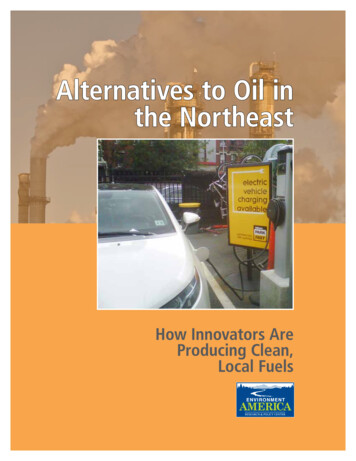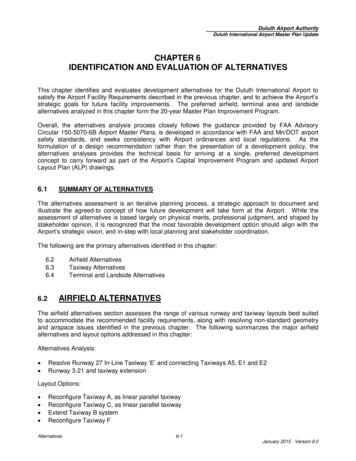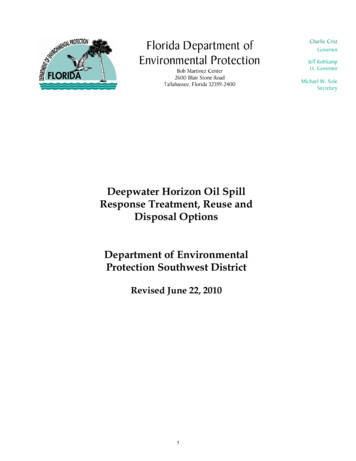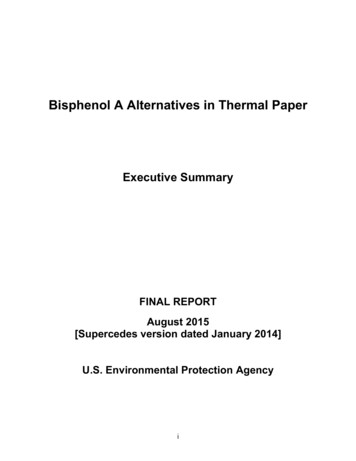
Transcription
Alternatives to Oil inthe NortheastHow Innovators AreProducing Clean,Local Fuels
Alternatives to Oilin the NortheastHow Innovators AreProducing Clean, Local FuelsWritten byElizabeth Ridlington and Jordan Schneider, Frontier GroupDan Gatti, Environment America Research & Policy CenterFall 2012
AcknowledgmentsEnvironment America Research & Policy Center thanks the following individuals whoprovided information, perspective or review for this document: Dr. Robert Parette,Project Manager with Matson Biofuels; Michael Guarnieri, District Manager for Edison ParkFast; Dick Arnold, President of Old Town Fuel & Fiber; Dehran Duckworth,Partner with Tri-State Biodiesel; and Carol Lee Rawn at Ceres. The authors wishto thank Tony Dutzik of Frontier Group and Carolyn Kramer for editorial support.Environment America Research & Policy Center is grateful to the Mertz GilmoreFoundation and the Energy Foundation for making this report possible.The views expressed in this report are those of the authors and not necessarily those ofreviewers, funders or those who provided information. The authors bear responsibility for any factual errors. The recommendations are those of Environment AmericaResearch & Policy Center. 2012 Environment America Research & Policy CenterEnvironment America Research & Policy Center is a 501(c)(3) organization. Weare dedicated to protecting America’s air, water and open spaces. We investigateproblems, craft solutions, educate the public and decision makers, and help Americans make their voices heard in local, state and national debates over the quality ofour environment and our lives. For more information about Environment AmericaResearch & Policy Center or for additional copies of this report, please visit www.environmentamericacenter.org.Frontier Group conducts independent research and policy analysis to support a cleaner,healthier and more democratic society. Our mission is to inject accurate informationand compelling ideas into public policy debates at the local, state and federal levels.For more information about Frontier Group, please visit www.frontiergroup.org.Cover photos: Background: Henryk Sadura via ShutterstockForeground: Edison ParkFastLayout: To the Point Publications, www.tothepointpublications.com
Table of ContentsExecutive Summary . . . . . . . . . . . . . . . . . . . . . . . . . . . . . . . . . . . . . . . . . . 4Introduction . . . . . . . . . . . . . . . . . . . . . . . . . . . . . . . . . . . . . . . . . . . . . . . .7Why We Need Alternatives to Oil Now . . . . . . . . . . . . . . . . . . . . . . . . .9Bringing Electric Vehicles to Consumers . . . . . . . . . . . . . . . . . . . . . . . . . 13Building Public Recharging Stations: Edison ParkFast . . . . . . . . . . . . . . . . . . . . . . . . . 13Bringing Sustainable Biofuels to the Market . . . . . . . . . . . . . . . . . . . . . 16Developing Renewable Jet Fuel: Old Town Fuel & Fiber . . . . . . . . . . . . . . . . . . . . . . . 17Collecting Local Feedstock: Tri-State Biodiesel . . . . . . . . . . . . . . . . . . . . . . . . . . . . . . 18Turning Waste Oil into Biodiesel: Matson Biofuels . . . . . . . . . . . . . . . . . . . . . . . . . . . 19Making Sure that Alternatives to Oil Are Good for the Environment . . .21Looking Beyond the Tailpipe: The Life-Cycle Impacts of Transportation Fuels . . . . . . . 21Corn Ethanol . . . . . . . . . . . . . . . . . . . . . . . . . . . . . . . . . . . . . . . . . . . . . . . . . . . . . . . . 22Soy Biodiesel . . . . . . . . . . . . . . . . . . . . . . . . . . . . . . . . . . . . . . . . . . . . . . . . . . . . . . . . 23Natural Gas . . . . . . . . . . . . . . . . . . . . . . . . . . . . . . . . . . . . . . . . . . . . . . . . . . . . . . . . . 24Algae-Based Biofuels . . . . . . . . . . . . . . . . . . . . . . . . . . . . . . . . . . . . . . . . . . . . . . . . . 25Policy Recommendations . . . . . . . . . . . . . . . . . . . . . . . . . . . . . . . . . . . . . 27Notes . . . . . . . . . . . . . . . . . . . . . . . . . . . . . . . . . . . . . . . . . . . . . . . . . . . .29
Executive SummaryDependence on oil harms theNortheast’s environment ande c o n o m y. I n n o v at o r s a n dentrepreneurs are working to developthe fuels of the future: clean alternativesto oil that are less polluting and can beproduced right here in the region.Those efforts can only take root andgrow if Northeastern states make a firmpolicy commitment to integrating cleanalternative fuels into our transportationfuel mix. Adoption of a regional CleanFuel Standard will provide a criticalshot in the arm to innovators andentrepreneurs in our region, whilebringing the region closer to cutting ourdependence on oil.The Northeast’s heavy reliance on oilpollutes our air and exacerbates globalwarming. Oil consumption contributes to globalwarming, which is predicted to havea heavy impact on the Northeast. Bythe end of the century, snow seasoncould be half its current length.Summers will be hotter, with as manyas 30 days per summer in Philadelphia with temperatures over 100 F.Higher sea levels could leave bothNew York City and Boston vulnerable to flooding during high tides andcoastal storms like Superstorm Sandy. Oil consumption causes air pollution that harms human health. Usingpetroleum products creates groundlevel ozone (smog) and particulatematter pollution (soot). Both of thesepollutants can cause or aggravate ahost of health problems, including4 Alternatives to Oil in the Northeast: How Innovators Are Producing Clean, Local Fuels
cardiovascular disease, asthma, andlung cancer. More than 38 millionpeople in Northeastern states livein areas with unhealthy air.Businesses and consumers in theNortheast suffer financially from ourdependence on oil. In 2010, Northeastern consumersand businesses spent 121 billionon petroleum products, 99 percentof them from outside the region.The money was equal to morethan 3 percent of all economicactivity in the Northeast. Our heavy reliance on oil leavesconsumers vulnerable to theimpact of fluctuations in petroleum prices, such as this year’ssurge in gas prices to more than 4 per gallon. In the Northeast,where roughly one quarter ofhomes are heated with oil, manyfamilies are particularly vulnerableto jumps in oil prices.Domestically produced, cleanalternatives to oil exist today andcompanies across the Northeast areworking to bring those fuels andtechnologies to consumers.Northeastern entrepreneurs areworking to make vehicles poweredby electricity a clean and convenientalternative to oil-powered cars andtrucks, by building the recharginginfrastructure needed by electricvehicles. Edison ParkFast is installing electric-vehicle chargingstations at its parking facilities inNew York and New Jersey. Bothcommuters who need to rechargea vehicle for the commute homeand apartment-dwellers whodon’t have a way to recharge theirvehicle at home use the facilitiesinstalled by the New York-basedcompany.Entrepreneurs across the Northeasthave developed sustainable, locallyproduced biofuels that they noware seeking to produce and market inbigger quantities. Old Town Fuel & Fiber processeswaste from Maine’s timber industry into bio-butanol that can berefined into jet fuel. With help fromresearchers at the University ofMaine and with funding from theU.S. Department of Energy, OldTown Fuel & Fiber has designed andbuilt a pilot plant that can be scaledup to produce and refine about 1.5million gallons of jet fuel annuallyfrom wood waste. The company nextintends to build a full-scale facilitywith 10 times the present capacity. New York City’s thousands of restaurants generate waste cooking oil thatcan be purified and refined for useas biodiesel. Each month, Tri-StateBiodiesel collects 250,000 gallonsof waste oil from restaurants in NewYork City, as well as in Connecticutand New Jersey. The company thenfilters the oil before selling it tobiodiesel refineries. Matson Biofuels in Pennsylvania has developed a biodieselrefining process that can producebiodiesel from both high-qualityand low-quality feedstock. The newprocess allows more efficient production of biodiesel that increases yield,reduces water consumption duringprocessing, and lowers costs.Not all alternative fuels are clean. Somealternatives to oil also produce significantamounts of global warming pollution,while others raise new environmentalconcerns.Executive Summary5
Ethanol based on corn and biodieselmade from soybeans are energyintensive to grow and process, andadd to soil erosion and pesticidepollution. Natural gas produced by hydraulicfracturing (“fracking”) may havehigher emissions than petroleum. Algae that have been genetically engineered can produce largevolumes of oil for refining intovehicle fuel. While this algae-basedoil may deliver emissions benefits,the use of genetically modifiedorganisms raises grave concernsabout potential broader ecologicalimpacts.Adoption of a regional Clean FuelsStandard will speed the integration ofalternatives to oil into the Northeast’sfuel supply while ensuring that thosealternatives deliver real benefits forthe environment. Such a standardwould require the use of an increasingamount of clean, alternative fuels andlimit the amount of global warmingpollution produced by a gallon of fuel.By adopting a Clean Fuels Standard,the region can hasten developmentof alternatives to oil here in theNortheast, and make sure that thosealternatives contribute to a cleaner,healthier future.6 Alternatives to Oil in the Northeast: How Innovators Are Producing Clean, Local Fuels
IntroductionThe Northeast’s dependence ontraditional sources of oil will cometo an end—probably soon. Thequestion is what will replace it.The world is running out of easy-toobtain oil, with more and more of our fuelcoming from “unconventional” sourceslike Canadian tar sands.One option is for the Northeast torely on these and other fossil fuels, suchas coal-to-liquids, tar sands, oil shale, ornatural gas—swapping dependence onone polluting, finite source of energy withdependence on another. Some of thesefuels may even be more polluting thanthe traditional sources of oil they replace.Another option would be for theregion to switch to other alternatives that,while not fossil fuels, come with their ownenvironmental impacts. Corn ethanol,unsustainably produced biomass, andfuels produced with the help of geneticengineering may curb our dependence onoil, and in some cases even reduce globalIntroduction7
warming pollution, but not withoutmajor potential impacts on importantecosystems and public health.There is, however, a third path—one inwhich the Northeast commits to gettingoff oil and endeavors to do it the rightway from the very start, by encouragingthe use of clean, alternative fuels that aresubstantially better for the environmentthan oil.Fuels like electricit y (especiallyelectricity from renewable sources) andsustainably sourced biofuels can helpthe Northeast move down that path toa cleaner future without dependence onfossil fuels. Innovators and entrepreneursthroughout the region are working onsolutions that will bring that futurecloser to reality—developing new fuels,new vehicle technologies, and new waysof integrating clean alternatives into ourtransportation system.I n t h is repor t , we h igh l ighttechnologies and practices with realpromise for moving the Northeastbeyond oil, and the people and companiesin the region that are driving thoseinnovations forward. By implementinga Clean Fuels Standard that moves theregion toward alternatives to oil andensures that those alternatives are goodfor the environment, the northeasternstates can help bring those technologiesand practices to scale and spark new wavesof innovation that can help us break ourdependence on oil once and for all.8 Alternatives to Oil in the Northeast: How Innovators Are Producing Clean, Local Fuels
Why We Need Alternatives to Oil NowThe Northeast’s dependenceon petroleum damages ourenvironment, contributing tohabitat destruction, oil spills, airpollution, water contamination, andglobal warming. It also harms oureconomy.Oil consumption in the Northeastalone was responsible for 3.5 percentof the world’s emissions of carbondioxide (CO2), the leading globalwarming pollutant, in 2009.Global Warming PollutionThe Northeast is highly dependenton petroleum. In 2009, the regionconsumed 1.1 billion barrels ofpetroleum products, 16 percent of thenation’s total.1 Oil consumption in theNortheast alone was responsible for3.5 percent of the world’s emissionsof carbon dioxide (CO2), the leadingglobal warming pollutant, in 2009.2The bulk of the petroleum-relatedCO2 emissions produced in the regioncomes from transportation, includingpersonal travel in cars, light trucks andSUVs; freight shipping by truck andtrain; and airplane travel. Petroleumconsumption in the transportation sectoraccounts for the largest portion (38Why We Need Alternatives to Oil Now9
percent) of global warming pollution inthe Northeast each year.3 Oil burned forhome heating is also a significant sourceof CO2 emissions, accounting for 46percent of all residential emissions.The effects of global warming arealready beginning to be felt in theNortheast. The average temperaturein the Northeast has increased by morethan 2 F over the last 40 years, andtemperatures could rise by an additional4 F in the coming decades if globalwarming pollution worldwide continuesunabated.4 Extreme weather events, suchas heavy precipitation, have becomemuch more common in recent years,especially in New England, where thenumber of extreme precipitation eventsbetween 1948 and 2011 increased by 85percent.5 Significantly for the Northeast’sski industry, a larger share of winterprecipitation is falling as rain rather thansnow and snowpack has been meltingearlier in the year.6The impacts of global warming willgrow in coming years. Winters will bemuch less snowy, with the winter snowseason half its current length in northernNew England by the end of the century.Summers will be far hotter. Boston couldhave as many as 20 days per summerwith temperatures over 100 F andPhiladelphia could have 30 such days.7With many of the Northeast’s majorcities located on the water and closeto sea level, the region is vulnerableto rising seas and higher storm surges,with flooding such as that experiencedfrom Superstorm Sandy becoming morecommon. By the end of the century, sealevel could rise by 2.3 feet in New YorkCity, and both New York City and Bostoncould be vulnerable to flooding duringhigh tides. 8 Production of importantcrops could decline. It may not bepossible to grow common varieties ofblueberries, cranberries and apples in theNortheast, and maple syrup production maybe limited to a very small area.9It is already too late to prevent many ofthe impacts of global warming. It is not toolate, however, to prevent the worst, mostcatastrophic impacts. The Northeast stateshave been leaders in taking action to curbglobal warming pollution, but the region’sdependence on oil is a major constraint onour ability to reduce emissions.Air PollutionPetroleum combustion is a major sourceof health-threatening air pollution. Oilcombustion creates nitrogen oxides (NOx)and volatile organic compounds (VOCs).These pollutants contribute to ozone smogand particulate matter, which creates soot.In 2008, oil consumption by highwayvehicles caused 37 percent of NOx emissionsand 39 percent of VOC emissions in theNortheast. Consumption of oil for homeheating produced additional ozone-formingpollution.10Smog and soot harm the health of millionsof Americans, causing cardiovascularproblems, strokes, heart attacks, respiratoryinfections, inflamed lung tissue, and asthmaattacks.11 More than half of all countiesin the Northeast—60 percent—receivedfailing grades from the American LungAssociation for unhealthy air from ozonepollution. More than 38 million people livein these areas. (See Table 1.)Water PollutionOil spills from drilling rigs, refineries,tankers, pipelines and storage tanks canfoul waterways and drinking water supplies.Spills from even a small amount of oil cancontaminate large volumes of groundwater,rivers, lakes or coastal waters. In April 2003,an oil barge ran aground in Buzzards Bay,Massachusetts, spilling 98,000 gallons of10 Alternatives to Oil in the Northeast: How Innovators Are Producing Clean, Local Fuels
oil.13 Approximately 500 birds died asa result of the spill, and, as of 2011,some areas of the bay remained closedto shellfishing.14Leaking underground storage tanks,all too common across the Northeast,create myriad points of groundwaterpollution and jeopardize drinking watersupplies. Over the years, more than100,000 underground storage tankshave leaked in the Northeast.15 Thoughmany of those have been cleaned up,with 100,000 active tanks still in theground, new leaks will appear.Economic ImpactsThe Northeast imports 99 percentof all the oil it consumes: we have veryfew production facilities.16 As a result,every dollar spent on oil is a dollar thatleaves the region’s economy. In 2009,consumers in the Northeast spent 121 billion on petroleum productsfor transportation, heating, and otheractivities.17 That represents 3.7 percent ofall economic activity in the region.18Although alternative fuels may not becheaper at the pump than petroleum (at leastinitially), they are home-grown. Shiftingeven a fraction of our oil consumption tolocally produced fuels would put billionsof dollars back into the region’s economy.Locally produced fuel means local jobs.In the Midwest, the typical biofuel refineryemploys 35 people.19 For the Northeasternstates, investing in alternative fuels willmean jobs producing and distributingfuels, and building and maintaining theinfrastructure needed to use alternativefuels.In addition, reliance on fuel from outsidethe region leaves families vulnerable toprice spikes. The global economic forcesthat rule the international market for oilcan cause wild fluctuations in the price ofpetroleum in the Northeast, evidenced bythis year’s surge in gasoline prices to moreTable 1. Tally of Counties Receiving “F” Grades for Unhealthy Air andAffected Population, by State12StateNumberofCountiesNumber ofCounties FailingOzone StandardPopulation achusetts1494,711,000New Hampshire103737,000New Jersey21115,049,000New York62169,292,000Pennsylvania67208,626,000Rhode Island53923,000Vermont1400Total1478638,135,000Why We Need Alternatives to Oil Now11
than 4 per gallon. When prices increase,most Americans are unable to reducetheir demand for petroleum. Familiesmust continue commuting to work andheating their homes. In the Northeast,where roughly one quarter of homesare heated with oil, many families areparticularly vulnerable to jumps in oilprices.In order to address the problems of theNortheast’s heavy reliance on oil, we mustfind alternatives. Fortunately, sustainable,locally produced fuels are available, andinnovators and entrepreneurs in theregion are working hard to bring thosenew fuels to the market.12 Alternatives to Oil in the Northeast: How Innovators Are Producing Clean, Local Fuels
Bringing Electric Vehicles to ConsumersElectricity has the potential todisplace much of the oil used fortransportation while reducingair pollution and other environmentalimpacts. With infrastructure already inplace for generating, transmitting anddistributing electricity, it could enterwidespread use quickly. In addition,electric-powered vehicles have a smallerenvironmental impact than vehiclespowered by oil.Hybrid-electric, plug-in hybrid andfully electric vehicles are becomingincreasingly common sights on highwaysin the Northeast, and the number ofthose vehicles on the road is likely togrow as automakers launch new modelsof vehicles that run, in whole or inpart, on electricity. Edison ParkFast isconstructing public recharging stationsfor electric vehicles, helping to addressdrivers’ concerns about recharging theirvehicles away from home.Building Public RechargingStations: Edison ParkFastThe Northeast’s dense urban areas arewell-suited for electric vehicles. Most cartrips are relatively short, and most driversdon’t need a vehicle with a range ofhundreds of miles. The biggest challengeof owning an electric vehicle for manycity-dwellers may be figuring out howto recharge it, either during the day atwork or overnight at a home or apartmentwithout a garage. Edison ParkFast hasBringing Electric Vehicles to Consumers 13
begun to address this challenge by addingelectric vehicle charging stations to itspublic parking facilities.Edison ParkFast is one of New YorkCity’s oldest parking services companies.Since its founding more than 55 yearsago, the company has established dozensof parking locations in lots and garagesin the New York metro area, including innorthern New Jersey.In June 2010, the company beganoutfitting all of its 24-hour parkinglocations with high-voltage chargingstations for plug-in electric vehicles,with help from a U.S. Department ofEnergy program designed to acceleratethe development and launch of electricvehicles (EVs) and electric vehiclecharging infrastructure in nine regionsacross the country.20According to Michael Guarnieri,district manager for the company,ParkFast’s decision takes advantage ofthe program. Installing the chargingstations was partially in response toNew Yorkers’ excitement about electricvehicles.“In 2009, everyone was talking aboutelectric vehicles. It was the focus of thecity and of the mayor,” Guarnieri said.“We figured there was no better place tooffer charging stations for electric carsthan at our parking locations throughoutthe city.”Edison ParkFast offers 220-volt or“level II” charging, which can chargea vehicle in 1-4 hours, at 19 of its 24hour locations throughout the city andin New Jersey. The company offers110-volt or “level I” charging, whichAn Edison ParkFast electric vehicle charging station in New York.14 Alternatives to Oil in the Northeast: How Innovators Are Producing Clean, Local FuelsPhoto: Edison ParkFast
charges vehicles in 10-12 hours, at theselocations as well.In New York City, the marriage ofelectric vehicle charging with parkingservices makes sense, Guarnieri said.“In New York, you can’t run anextension cord from your apartment onthe 19th floor to your car parked on thestreet,” he said. “Even if it’s low-levelcharging, it still solves a lot of logisticalproblems for residents in places likeManhattan.”The level II stations are popular,according to Guarnieri. He said NewYorkers looking to buy electric vehiclesoften call him to ask him where thecompany’s level II charging stations arelocated.“They want to know that if they buyan electric vehicle, they’ll be able tocharge it at level II,” he said. Due tothese concerns about accessibility, EdisonParkFast prioritizes its 24-hour locationsfor charging station installation.In New York, you can’t run anextension cord from your apartmenton the 19th floor to your car parkedon the street.– Michael Guarnieri, Edison ParkFast“If someone is running out of chargedowntown, we want them to have accessto charging that will get them home,”he said.Since ParkFast installed its firstcharging station in 2010, it has providedelectricity to all of its EV customersfor free—regardless of the amountof electricity they use—in order toencourage more of them to be monthlycustomers.Bringing Electric Vehicles to Consumers 15
Bringing Sustainable Biofuelsto the MarketBiofuels, or fuels that come fromrenewable, biological sources ratherthan fossil deposits underground,can directly replace gasoline and dieselin today’s combustion engines and havethe potential to reduce harmful emissions from the transportation sector.Some biofuels, such as those producedfrom plant fiber or waste material, havea smaller environmental impact thangasoline or diesel. Ethanol producedfrom agricultural waste and biomass, andbiodiesel from waste cooking oil produceless global warming pollution than cornor soy-based fuels do. (See “Making Surethat Alternatives to Oil Are Good for theEnvironment” on p. 21 for a morecomplete discussion of the environmental impact of different fuels.)Innovators and entrepreneurs inthe Northeast already produce andsell sustainable, alternative fuels suchas biodiesel and bio-butanol, butthey are looking for ways to expandproduction. In Maine, Old Town Fuel& Fiber has developed a process toturn wood waste into jet fuel. NewYork’s Tri-State Biodiesel collectswaste cooking oil from restaurantsfor eventual processing into biodiesel.Matson Biofuels in Pennsylvaniahas created a technology to convert16 Alternatives to Oil in the Northeast: How Innovators Are Producing Clean, Local Fuels
many types of waste oils into biodieselinexpensively.Developing Renewable JetFuel: Old Town Fuel & FiberOld Town Fuel & Fiber, a wood pulpmill operating since the late 1800s on thePenobscot River, had struggled throughtwo closures by the time Lynn Tilton,CEO of an investment group, boughtit in 2008. Despite failed plans by theplant’s previous owners to use some of theplant’s waste wood product to producecellulosic ethanol, Tilton decided to focuson producing bio-butanol and refining itinto jet fuel.“Lynn felt that ethanol wasn’t the wayto go,” said Dick Arnold, president ofOld Town Fuel & Fiber. “The long-termplan was always to produce jet fuel, andthe pathway we discovered was throughbio-butanol.”In contrast to ethanol, bio-butanolis not corrosive and can therefore betransported through existing pipelines. Itcan also be blended in higher percentagesw it h g a s ol i ne w it hout e x ten sivemodifications to existing engines.T he de c i sion to pro duc e bio butanol at Old Town also provided anopportunity for vertical integration withanother of Tilton’s acquired companies,McDonnell-Douglas Helicopters (nowMD Helicopters). The company wasstarted in 1955 by Hollywood andaviation mogul Howard Hughes.Tilton and her team, which includedresearchers at the University of Maine,earned a 30 million financial assistancepackage from the Department of Energy(DOE) for the demonstration projectto produce bio-butanol at Old TownFuel & Fiber. According to Arnold, theDOE vigorously supports developmentof alternative transportation fuels,particularly jet fuel.Old Town Fuel & Fiber’s facility on the Penobscot River in Maine hasdeveloped technology that enables the production of jet fuel fromwood waste. Photo: Old Town Fuel & FiberWith the DOE’s assistance, Tilton’scompany designed and constructed a pilotplant at Old Town Fuel & Fiber capable ofproducing and refining bioproducts. Thatplant can be scaled to the demonstrationproject of 1.5 million gallons of jet fuelper year from bio-butanol generatedfrom wood waste. The company can alsoapply the technology in use at the OldTown plant to other wood pulp millsin the region. Additionally, it can applya process for completely converting apulp mill into a full-scale jet fuel facility.Full scale facilities would be capable ofgenerating around 15 million gallons ofjet fuel annually, according to Arnold.Currently, only the pilot plant at OldTown is operating. Before a full-scaleproduction plant can be constructed,and before the company can exportits technology to other plants, OldTown Fuel & Fiber must obtain capitalfinancing from the DOE, according toArnold.Bringing Sustainable Biofuels to the Market17
“We need to qualify for ‘procurementand construction’ phase financing,” hesaid. In order to qualify, the companymust prove its technology at its pilot plantand demonstrate that it can effectivelyproduce and sell jet fuel on the marketwithout subsidies.“Our biggest challenge is being firstto the market. Leading-edge technologyhas a lot of risks attached to it; we’realways going back to evaluate how muchrisk we’re taking on,” Arnold said. “Butkeeping technology in the U.S. andkeeping manufacturing in the U.S. isreally what drives all of this.”Collecting Local Feedstock:Tri-State BiodieselBiofuels don’t just come from the farmor the forest. Sometimes they come fromthe heart of the city.Biodiesel made from waste oil isenvironmentally beneficial and mostreadily available in big cities, making itan ideal fuel to develop in the denselypopulated Northeast. Biodiesel can bean attractive alternative to petroleumdiesel; when feedstock supplies aregrown sustainably or refined fromrecycled cooking oil, biodiesel producesfar less carbon dioxide pollution thanpetroleum.21New York-based Tri-State Biodieselcollects and filters more than 250,000gallons of waste cooking oil every monthfrom restaurants in Connecticut, NewYork and New Jersey. The companystarted after its founder, Brent Baker,toured restaurants in Northeastern citiesfor several years in his own biodieselpowered bus, collecting waste cooking oilto demonstrate how it could be refinedwith the bus’s on-board filtration system;his mission was to spread the word aboutbiodiesel, according to company partnerand sales manager Dehran Duckworth.“We decided to scale up, to take it astep further. We built a business planaround collecting oil,” Duckworth said.“You can have 100 biodiesel plants, butif you don’t have the feedstock, it doesn’tdo any good.”Since Baker started the company in2006, Tri-State’s collection truck fleet hasexpanded to 15 vehicles. The companyemploys more than 60 people in theBronx alone, and its other employeesare based in Connecticut, New Jersey,Philadelphia and Washington, D.C.Tri-State filters the waste oil it collectsuntil it reaches the same quality as virginoil, or oil derived directly from a p
as biodiesel. Each month, Tri-State Biodiesel collects 250,000 gallons of waste oil from restaurants in New York City, as well as in Connecticut and New Jersey. The company then filters the oil before selling it to biodiesel refineries. Matson Biofuels in Pennsyl-vania has developed a biodiesel refining process that can produce











